Throughout my education in high school and college, I was told I was a strong writer. I always got A’s on my papers in high school without even really trying that hard. Looking back, I realize that although I am a good writer, no one ever bothered to push me further, challenge me with a difficult topic, or even play Devil’s Advocate with me. That is, until I got to college and started Writing 39B. In that class, I was pushed, critiqued, and criticized endlessly, but it really paid off in the end because I became stronger because of it. A year later, I started 39C, still thinking that I was a pretty good writer, but knowing that a year without writing had left me more than a little rusty. I hoped that this class could make my writing even better if someone took the time to take apart my essays and point out all the different flaws that were hiding in them. Honestly, I was terrified, because research had never been my strongest point; I always used to research as I went along, thinking up an argument, and then googling a source to support my idea. I had no respect for the credibility of the sources I was using, nor was I very good at implementing them into my papers. I had heard things about 39C, and I realized from day 1 that I would not be able to get away with that kind of research in this class. I knew that this class would take me seriously as a writer, so I had to take it seriously in return.
I definitely got what I asked for right away. There was a lot of preliminary work that had to be done before I could even start my HCP. The reading assignments, class discussions about these readings, and the discussion board posts on Canvas were all building up to our first paper, in which we were only supposed to talk about the different sides and debates of our topics, remaining completely neutral.
Research and Composition
By the time week 3 rolled around, it was time to start researching, and I mean really researching. Thank goodness we had a meeting with a librarian to help walk us through the steps of finding and utilizing credible and workable material, otherwise I would have been lost in a sea of random sources I was able to pull up through Google. Researching was a lot of work, but it was nice having the research done, and being able to formulate an opinion on the topic before I sat down to write, instead of researching and making snap-judgement opinions on things as I was writing my papers, as I had done previously. Below is a section of notes I took during the librarian's lecture on how to do proper research; I only included the lines and post-it notes that had important research I had found that ended up being very important to my paper, including experts and Supreme Court cases.
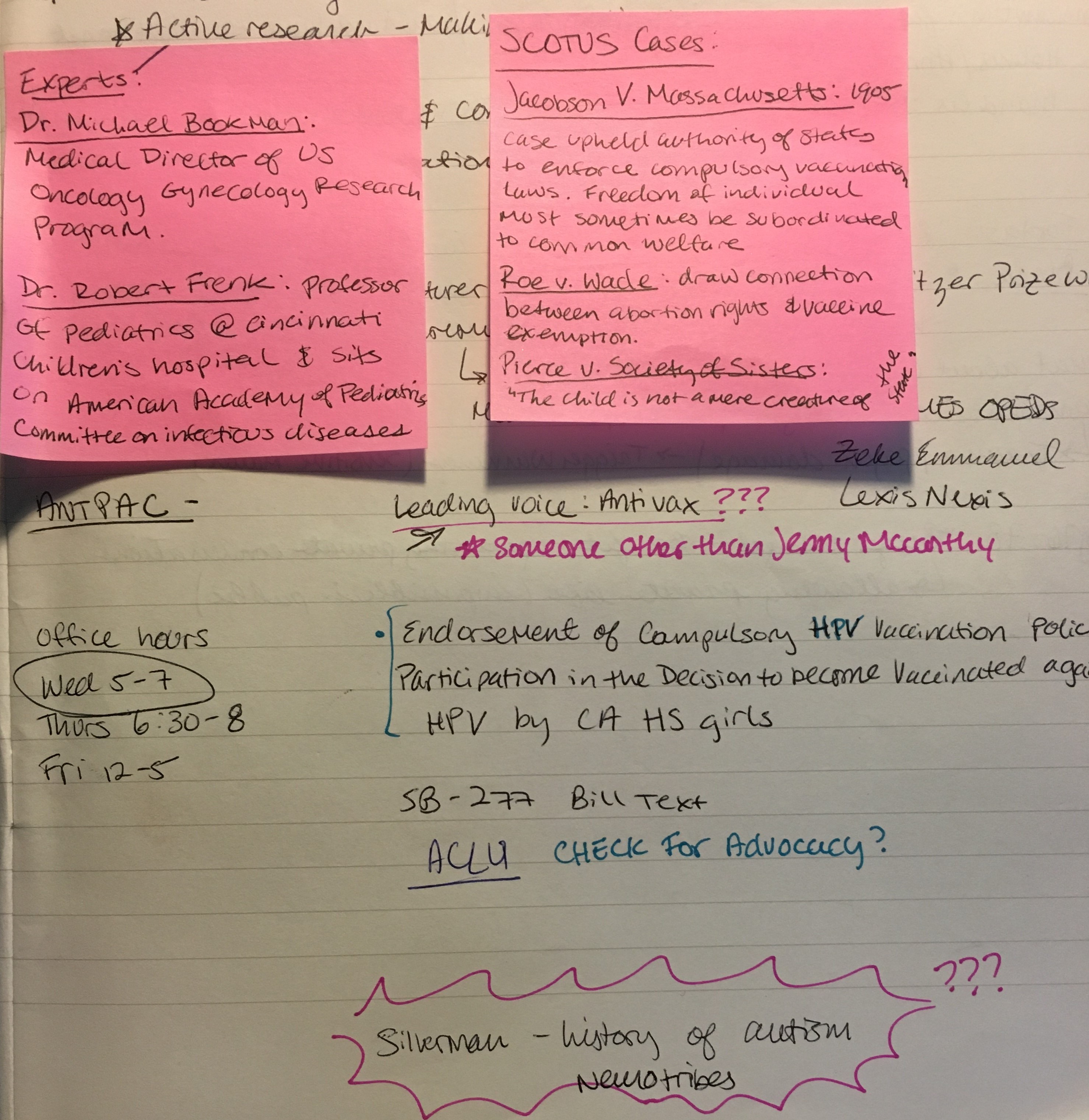
But honestly, I didn’t keep a log of all the sources I had used, and I paid for it later when I had to write an annotated bibliography, and couldn’t find half of my sources. That was perhaps one of the most important lessons I learned in the composition process: keep track of your sources; anything that you read or think you might use, write it down!
This brings me to my pre-writing work. I always thought outlines were a waste of time, and I just let my writing take me wherever it needed to go. That changed this year when I had so many different perspectives, opinions, and information swirling around, I had to have at least an outline of an outline to keep me on track. Pictured below is one of the first HCP outlines I did. In Pink is everything I originally intended on putting in my paper; everything in Blue was yet another thing I had to consider and research after I met with Brendan and he read my proposals.
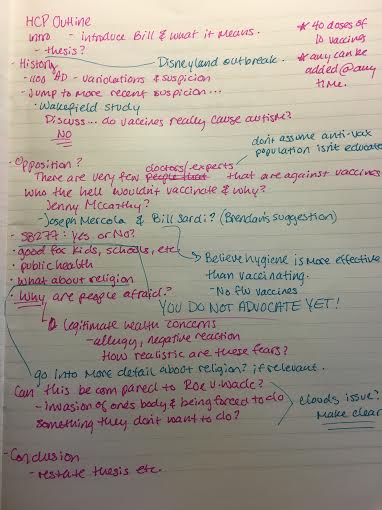
Having a clear idea about the argument I chose for my HCP really helped me later in my Advocacy project. I knew how I wanted it to be structured, what arguments I could use. It was just a matter of finding that sweet spot in the middle of the vaccination debate that made things a little difficult. I had gone through the whole process of the HCP without questioning what side I was on; I was in favor of science and the law. But once the AP came around, I had some doubts. In one of my meetings with Brendan, he said something that I hadn't really thought of before, "The anti-vaxxers may be idiots, but they're idiots with a legitimate concern and a constitutional claim." I couldn't argue with that. So I laid out my ideas about what I thought would be the best approach to advocating for a solution to the vaccine problem, like in the picture below.
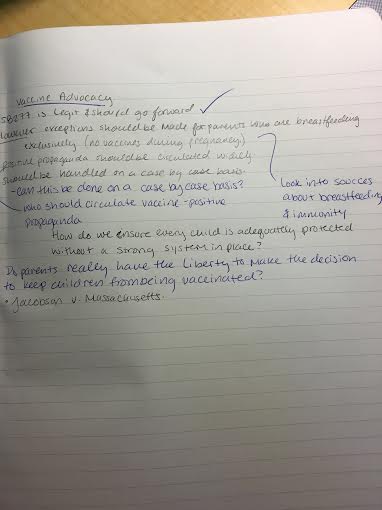
This was my guiding document while I was writing my AP. I wrote down my initial thoughts about what I think about Senate Bill 277, and what I think a middle ground in the vaccine debate looks like. I decided first and foremost that the bill was constitutionally legitimate, and should go forward. However, there was something about how rigidly the bill enforces vaccines on all families in California, and how one of the biggest changes in the bill is the removal of the parent's right to opt out of certain vaccines due to religious or personal beliefs that didn't sit right with me. One thing I learned through all of my research is regardless of how irrational they may be, fears of vaccines persist in our society, and something had to be done about them. I had to bring in questions like, "Do parents really have the liberty to make this kind of decision for the health of their child?" "Can this be handled on a case-by-case basis while insuring every child is adequately protected?" As well as "Whose job is it to circulate the positive propaganda?" Although this is not as thorough as the HCP outline that I pictured above, this paper was a lot more straightforward; in a lot of ways, the HCP itself was the outline and backdrop for the AP, so there was less composition work for me to do before turning in my prospectus.
My prospectus was a way more fleshed out blueprint of how I wanted my AP to look. But plenty of people had issues with it. It was full of mistakes, general citation errors, and missing information that I had in my head, but hadn't conveyed on paper yet, and it left some readers confused. I took their criticisms (pictured below) to heart, and tried to come up with a draft that would address some of these concerns.



Not only had I assumed that my readers already knew what I was thinking, I had neglected to cite pretty much everything, and I also didn't give any of my experts or leading voices any justification or credibility on the subject. It was a mess. To insure that I wouldn't make the credibility mistake again, I went through and made a post-it note for all of the leading voices and experts that I would have potentially used in my AP (pictured below). I knew I had to slow down, start over, and explain exactly what it was that I was talking about before I started drafting my AP.
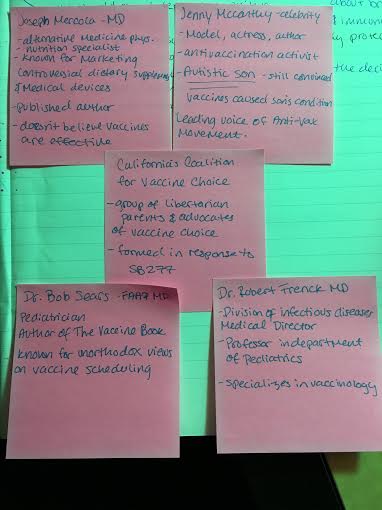
I have a tendency of getting really excited about a topic, I get way ahead of myself and end up sacrificing my organization. Having all this practice with the preliminary research and composition for the HCP and AP was really enlightening for me. I had never considered using so many post-it notes, or making so many different to-do lists, but in the end, this composition stage is what ended up saving my papers.
Arguing with and Incorporating Multi-modal Sources
I can honestly say that I have never had to write a paper using multi-modal sources before, and my first experience with it, in the HCP, was difficult. I had no idea what I was supposed to be putting pictures of. I had plenty of images and graphs to choose from, from all of the websites I researched, but I didn't know what to choose. I remember on one of the first drafts of my HCP, my peer reviewer Annie was pointing out that several of my images were "awkward" and "random." Not only was picking multi-modal images difficult, finding where to place them in my essay (where relevant and aesthetically pleasing), as well as explaining and citing these images was a very new and strange experience for me.

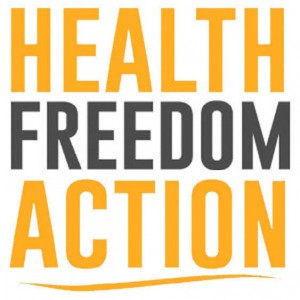
The photos pictured above were two of the most difficult multi-modal sources that I had to deal with. First, the tweet, which I felt was a very funny, sarcastic representation of the feud going on between pro-vaccination advocates and "anti-vaxxers," was hard for me to incorporate. I had to first make sure that I was allowed to use a tweet as multi-modal evidence, and then I had to construct a reason for it to be in my paper. I decided to place it within the paragraph that was discussing whether the bill was a free speech issue, in my HCP. While it was effective there, and it was good for some comic relief among a paper filled with depressing ideas and arguments, it was not cited correctly (I actually had to Google, "how does one cite a tweet?"), and I couldn't think of a good caption to try an incorporate it more seamlessly into my paper. I think in the end, it wasn't as strong of a multi-modal source as I had wanted it to be initially.
The picture next to the tweet was one of the pictures that Annie had described as "awkward/random/irrelevant." She was right. There was absolutely no use for that photo in my paper, as it was only adding color, not depth. I ended up removing it before I turned in another peer review. It was a valuable wake-up call for me. How do I determine what is useful in a paper, and not just pretty? I wanted my multi-modal sources to be relevant, and contribute to my argument in a positive way. I was able to do this with a great graph I found from the CDC (pictured below). I have used this graph in my HCP, AP, and the class presentation, because I felt like it really conveyed a good point to people that are either vaccine-hesitant or just completely ignorant to the issue.
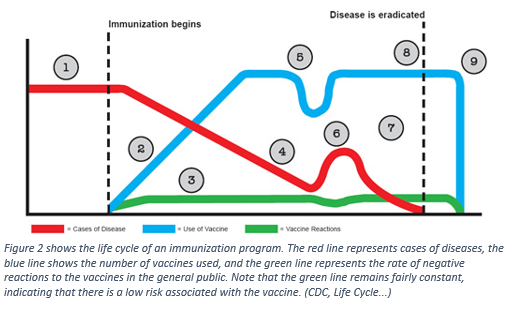
Like my description says, this graph demonstrates the life cycle of an immunization program. I really liked this graph because of the green line at the bottom, which represents the rate of negative or adverse reactions to any given vaccination; and it stays perfectly level throughout the immunization program. One of the main ideas I tried to convey with this is that vaccines are a medical procedure. No medical procedure goes without some element of risk; so yes, there will be children and adults that have horrible allergies to vaccines, there will be rare cases of shock, encephalitis, and even death. But it is not the norm. The norm is what the red line indicates, that the disease rates will start to decline, thus saving lives. Where I had doubted my multi-modal evidence before, once I found this graph, and received a compliment on how well it worked in my paper, I felt assured that I would be able to bring the same impact from my other images.
If there is one thing I can confidently take away from this class, it's that I have learned to utilize and correctly caption multi-modal sources, and use them to further drive a point home, and help convey an important point to my readers.
Revisions
This was perhaps one of the toughest and most tedious parts of my papers. I have always had a tough time with revisions, because I write how I think in my head, and that doesn't always translate well to other readers. Throughout this class, I have relied on my classmates, instructor, my family members, and even a few friends to read through my papers and give me constructive feedback. I find with revisions, people are afraid to be mean, or simply don't have enough information on the topic to ask constructive questions. Having a large network of peer reviewers gives me many different people that are always finding something new for me to improve on in my papers, giving me a new perspective on something, or asking a new question. I was lucky enough to not have to change anything too drastically, a lot of the changes that go from draft to draft are slight, but these several little details and mistakes all add up to a better paper in the end. That's not to say I didn't have more than a few meltdowns and internal conflicts over vaccination laws while writing these papers. Sometimes I would get so overwhelmed, I would actually have to walk away from my paper to calm down a little bit. But once I came back with a clear head, that was when the best revisions happened.
Each time I revised my draft, I thought it was that much closer to perfect. However, every one that read my paper found that not only had my problems with citing my multi-modal sources persisted (I hadn't quite nailed down the art of captioning yet), things like smooth transitions, and phrasing were also things I could work on. I had to figure out how to connect my thought process in such a ways that my readers could easily follow it through my paper. I received comments like these on several drafts of my AP:


I decided I needed to take these kinds of comments seriously, and I started editing the specific lines that my readers had issues with, which tended to be the first and last sentences of each paragraph. After all the research I did, of course I was able to jump from topic to topic, already knowing what lies in the gaps, but I had to build bridges for those reading my papers, that had not spent the past 8 weeks researching vaccinations. I tried my best to clarify and make the transitions smoother (still something I struggle with). I have to say the most helpful resource for my awkward phrasing was Brendan, who made great suggestions on how I can make my sentences less amateurish. Comments like the ones pictured above are just a few examples of how he noticed a stiff or awkward part of a sentence, and recommended an alternative phrase for me to play with and build off of.
Another problem that I hadn't noticed that Brendan pointed out is that I tend to incorporate my quotations towards the end of my paragraph, and then don't do any analysis or further explanation of the quote.

As I looked through my paper, I found several places where I had neglected to "unpack" the quotations, and further analyze how they fit into my topic. It's comparable to the issues I was having with my multi-modal sources: they look really nice there, but are they actually contributing to my argument? I went through my paper and made sure that all the quotes that I was using were relevant to what I was talking about, and then thought about why I chose that specific quote. I had to justify it to myself in order to let the quote stay it in my paper, and then based on those justifications, I spelled out why that quote was relevant and important to my argument, and how it added to my overarching argument. Looking back on my previous drafts, I see now that having those quotes hanging there at the end all by themselves did little to contribute to my paper, and I am very happy with how I was able to shape my argument by doing something as simple as adding a few explanatory sentences after a quote.
One of the most important aspects of a paper is how it ends. I have always hated conclusions, and I was always taught to "restate the thesis, summarize main points, and broaden it to make a more applicable statement for readers." However if we think about it, nothing good ever ends in a summation of what came before it, like movies or novels, and if they do end like that, not many people read or watch them. Admittedly, this is a little harder with a research paper, there's very few ways that it can have an explosive or sentimental ending. So I had to find something in between: a call to action. But my conclusion went through quite a bit of revision before I reached a final product. This was one of the most challenging parts of my essay, because so few people that read my essay actually made it all the way to the conclusion (it was so much longer than any of my peers' drafts that I reviewed), so there was only a little bit of critique that I could go off of.
However, I could always rely on Brendan to find something that needed to be fixed anywhere in my paper. He left a few clarifying questions and suggestions on a draft of my AP, which was enough for me to make some significant changes that really rounded out my conclusion:

Because of the rigidity of SB 277, and how futile repealing the new law seemed to be, paired with the unlikeliness of one of my solutions, I had to concede. This issue is bigger than one college research paper, and I couldn't come up with a realistic solution that already exists. I had to make a call to action, urging for more research and education for parents that are vaccine-hesitant. But Brendan thought I could add more to my conclusion. Before, it was choppy, repetitive, and sounded defeated; once I got some good feedback on it (I sent it to my mom as well, and had her tell me what she thought), I tried rearranging some things, taking other things out, and rephrasing the topic sentence that was misleading. In the end, I had a complete conclusion that successfully conceded one of my ideas for a solution, as well as proposed a more likely solution and incited action among readers. I have included a snap shot of my final conclusion below, with the portions that I changed highlighted.
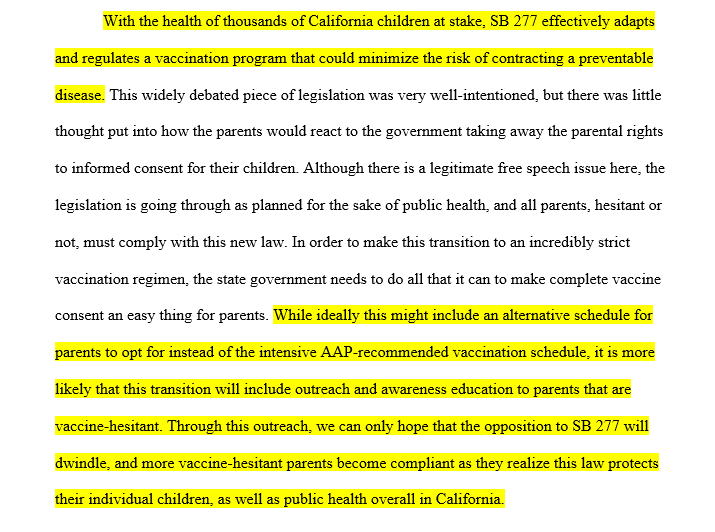
Undoubtedly, the revision process was frustrating, which is why I tried to avoid making any drastic changes in my HCP. In my AP, however, in order to advocate a strong stance and convince readers that although my solutions are a little out there and hard to make possible, they are still the best possible solutions for this issue. I had to revise my AP more thoroughly, and make sure that everything from the little grammar and phrasing mistakes to the complete rewrite of a conclusion are completed before turning in a final draft. No error in a paper is inconsequential, no matter how small it may be.
Application of what I learned
For having always been told that I am a good writer, this class sure had a LOT to teach me. I have never been challenged like this in my writing career. Countless hours researching, peer reviews, conferences with the instructor, and self-revisions was a lot of hard work, but I am happy to say it paid off in the end. I learned that I will not always be able to squeak by researching as I go, or just being able to crank out an entire essay the night before it's due to turn it in; there's much more to paper-writing than just writing. One thing that I started the quarter knowing I wanted to work on was my skills as a researcher, and I accomplished that goal, being proficient in locating and sifting through academic sources, news sources, and think tanks. I know that the skills I acquired in this class will help me in my later years at UCI, as well as into grad school, where I will be training to become a midwife, and having to use these skills to delve into volumes of medical journals and textbooks.
I also learned a lot about time management. Having many assignments and several drafts of each paper to work on could not be accomplished overnight like I have done for previous writing classes. Procrastination was my worst enemy in 39C, because although I chose a subject that I am passionate about, it's still so difficult to pull myself away from things like social media, or the TV. Yet one of the hardest things I had to come to terms with is the fact that I will never be "done" with my writing development. I walked into 39C expecting to learn how to time manage, and do acceptable research, and that would make me the best writer that I could ever be by the end of the quarter. This was not the case, because as I sit here typing, I can still think of all the things I wish I could have done, or would have done differently. I still see areas that I need to improve in, but I can honestly say I am a hell of a lot better than when I started. These past 10 weeks have been rigorous, tedious, and frustrating, but that doesn't outweigh the satisfaction I feel having completed this course, armed for anything research-related that may come my way in the years of schooling I have ahead.
 icons at the top right corner of the subsection.
icons at the top right corner of the subsection.